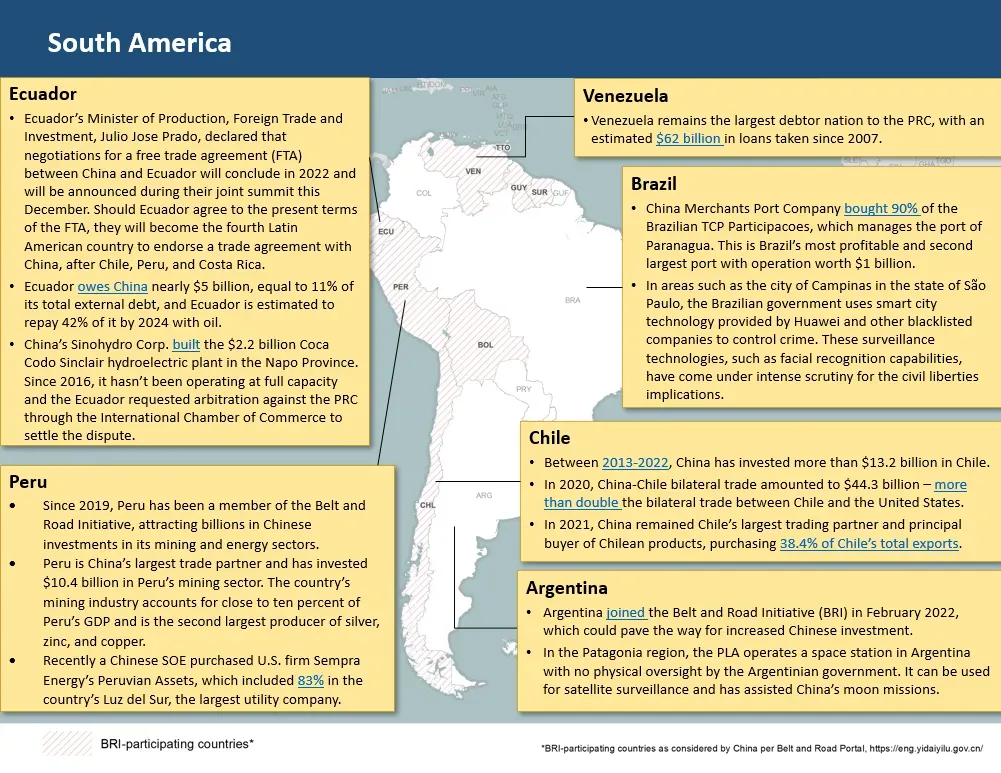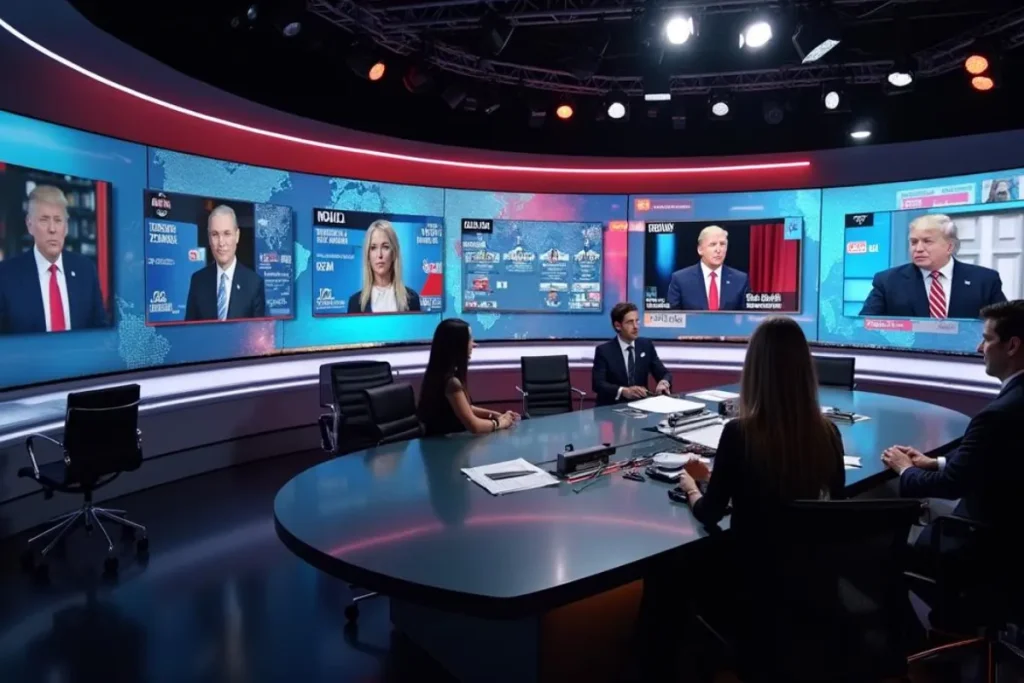The growing presence of China in Peru has raised eyebrows across the region, especially as Chinese investment in Peru continues to deepen its roots. Much of this influence can be traced back to key figures like Lima Mayor Rafael López Aliaga, who, amid speculations about his presidential run, is closely linked to initiatives such as the Belt and Road Initiative in Peru. This strategic collaboration encompasses vital infrastructure projects, including the PeruRail China connections that are pivotal for transporting resources. With Chinese investments flooding into sectors like electricity and mining, López Aliaga stands at the forefront of these developments, potentially bringing new challenges and opportunities to Peru’s political landscape. As the nation navigates this intricate relationship, understanding China’s influence in Peru becomes increasingly essential for the future of both countries.
Increasingly, the dynamics of international relations in Latin America are being reshaped by China’s engagement in Peru. This can be observed through a multitude of economic ventures involving significant Chinese investments, directing attention to various infrastructure initiatives like the Lima transportation projects. Political figures such as López Aliaga, who are seen as close to Chinese interests, may be instrumental in further promoting this bilateral agenda. The strategic implications of Chinese partnerships highlight a shift in Peru’s development trajectory, which is tied closely to the global ambitions encapsulated in the Belt and Road Initiative. As awareness grows regarding this geopolitical tug-of-war, it becomes vital to examine how these connections will dictate Peru’s future.
The Growing Influence of China in Peru
China’s strategic interests in Peru have grown significantly over the past decade, largely fueled by ambitious investments in key sectors, particularly mining and infrastructure. As one of the world’s largest consumers of copper and other minerals, China has sought to secure reliable supply chains from Peru, a nation rich in these resources. With such investments, China not only establishes its economic strength but also cultivates strong political alliances that could influence domestic governance in resource-rich countries.
The increasing Chinese investments in Peru have led to major developments, including the extensive funding of significant projects like the deepwater port in Chancay. This port, viewed as a pivotal point for China’s Belt and Road Initiative, enhances trade routes and furthers Chinese influence in South America. Alongside this, political figures like Lima’s Mayor Rafael López Aliaga have emerged as allies, indicating a potential shifting alliance that could reshape Peru’s geopolitical landscape.
Rafael López Aliaga: China’s Ally in the Presidential Arena
Rafael López Aliaga’s political aspirations appear intertwined with China’s economic ambitions in Peru. As mayor of Lima, he has positioned himself favorably towards Chinese investments, particularly through his company, PeruRail, which has benefited significantly from China-backed mining operations. With revenues rising due to increased partnerships with Chinese firms like Minera Las Bambas, López Aliaga’s financial ties to China have raised eyebrows and led to speculations about his stance towards foreign influence in Peru.
López Aliaga is seen not just as a local political figure but as a potential presidential candidate with strong backing from Chinese interests. His involvement in pivotal infrastructure projects in Lima underlines his importance to China’s long-term plans in the region. Should he pursue a presidential run in 2026, it remains to be seen how his connections to Chinese investments will influence Peruvian policies and its approach towards foreign relations.
Chinese Investment and the Belt and Road Initiative in Peru
The Belt and Road Initiative (BRI) has brought extensive Chinese investments to Peru, particularly focusing on critical infrastructure and resource sectors. This initiative promotes connectivity across nations and aims to enhance trade routes, with significant projects emerging in transportation, energy, and logistics. In Peru, major investments related to this initiative include the Chancay port and various mining ventures, reflecting China’s commitment to expanding its influence in the region.
Peru’s role as a central part of the BRI is underscored by its strategic mineral resources, essential for China’s industrial growth. The investment influx into Peru’s infrastructure—ranging from the Lima transportation projects to electricity supply—showcases how intertwined China’s ambitions are with Peru’s economic future, and highlights the potential political leverage that figures like López Aliaga could exert in guiding Peruvian policy in favor of Chinese interests.
PeruRail and Its Connections to Chinese Interests
PeruRail has emerged as a significant player in Peru’s transport sector, particularly benefiting from Chinese investment and the growing mining sector. With rising revenues driven by increased shipments from Chinese-owned mines, the company exemplifies the mutually beneficial relationship between local enterprises and foreign investors. López Aliaga’s connections to PeruRail underline the interconnectedness of local governance with international economic agendas, especially those aligned with China.
The success of PeruRail under López Aliaga’s management showcases the potential depth of Chinese influence in Peru’s transport infrastructure. As the reliance on Chinese investments continues to grow, the implications for Peru’s sovereignty and decision-making autonomy become increasingly complex. The political landscape could shift dramatically if López Aliaga successfully leverages these connections in his favor during the upcoming presidential elections.
The Implications of China’s Role in Lima’s Transportation Projects
Lima’s transportation infrastructure has seen a wave of investments from Chinese entities, aimed at modernizing and expanding the city’s capabilities. Projects funded by Chinese firms reflect a broader strategy to enhance transportation logistics, which is vital for economic growth and connectivity within the region. As the mayor, López Aliaga has been pivotal in promoting these projects, which not only modernize Lima’s infrastructure but also solidify China’s influence in Peru.
The emphasis placed on transportation improvements can be viewed as part of a larger geopolitical strategy. With rising urbanization and economic pressures, China’s investments present both opportunities and challenges for Peruvian policymakers. The involvement of figures like López Aliaga suggests a commitment to maintaining strong ties with Chinese partners, even as the country grapples with the implications of foreign influence on its national policies.
Peru’s Resource Wealth and China’s Strategic Interests
Peru’s abundant natural resources have made it a focal point for Chinese investment, particularly in the mining sector. China’s need for copper, lithium, and other minerals positions Peru as an essential supplier, creating a landscape where economic partnerships with a political flavor are commonplace. The proliferation of Chinese-funded projects in resource extraction not only bolsters Peru’s economy but also embeds China deeper into its socio-political framework, as illustrated by López Aliaga’s links.
As China continues to secure its resource inputs from Peru, the latter finds itself at a crossroads, balancing economic benefits against potential dependencies. The forthcoming presidential elections, particularly with candidates like López Aliaga who are closely tied to these interests, will play a critical role in shaping Peru’s resource policies and its relationship with China moving forward.
The Impact of López Aliaga’s Aspirations on Peruvian Politics
López Aliaga’s potential presidential run is poised to impact not only local governance in Lima but also the broader political landscape of Peru. His financial ties to China and his advocacy for Chinese-funded infrastructure projects position him as a pivotal figure in Peru’s political future, particularly as he navigates the complex dynamics of nationalism and foreign investment. His goals may align with enhancing ties with China, raising questions about national priorities.
If elected, López Aliaga could implement policies that further open Peru to foreign investments, particularly from China, potentially reshaping national discourse around sovereignty and economic autonomy. The implications of his leadership could determine how Peru capitalizes on its resources while managing external influences, with the outcome profoundly affecting the country’s political and economic narrative in the years to come.
Lima’s Relationship with Chinese Economic Power
Lima’s partnership with Chinese economic power reflects how local and global interests intertwine amid growing globalization. With significant investments in various sectors, including transportation and energy, Lima stands as a microcosm of the challenges and benefits that come with foreign investments. This relationship, particularly highlighted by López Aliaga’s leadership, poses questions regarding the implications of such economic dependencies on local governance and development.
As Lima continues to evolve through foreign investments, understanding the dynamics of its relationship with China is crucial for future policymaking. The decisions made by López Aliaga and other leaders could shape the future of not just urban development but also Peru’s strategic positioning within the international arena, balancing exploitation of economic opportunities with the challenges of maintaining sovereignty.
Emerging Challenges in Peruvian-Chinese Relations
Despite the economic benefits brought about by Chinese investments in Peru, there are emerging challenges that warrant consideration. Concerns regarding environmental sustainability, labor practices, and national sovereignty emerge as critical issues that the government must address. As mining operations expand, the potential for social unrest and environmental degradation increases, prompting a need for transparent governance that considers the rights and wellbeing of local communities.
López Aliaga’s approach to these challenges could determine how Peru navigates its relationship with China moving forward. If he could successfully integrate local needs into foreign policy discussions and investments, it may not only foster economic growth but also enhance social stability in the long term. As the dialogue surrounding foreign influence continues, the next presidential term will be crucial in addressing these multifaceted issues.
Frequently Asked Questions
How is China influencing Peru through the López Aliaga presidential run?
The López Aliaga presidential run is seen as a pivotal moment for China’s influence in Peru. His financial ties to China, particularly through his company PeruRail, highlight a strong connection that may benefit Chinese investment in the country, aligning with the broader Belt and Road Initiative in Peru.
What impact does Chinese investment in Peru have on local politics?
Chinese investment in Peru significantly impacts local politics by creating political alliances, as seen with Rafael López Aliaga. His connections to Chinese enterprises enhance China’s foothold, potentially swaying policy decisions in favor of further Chinese projects, such as those in mining and infrastructure.
What are the implications of PeruRail’s connections to China on Peru’s economy?
PeruRail’s connections to China have boosted revenue, making it a crucial player in the transport of minerals. With increased shipments from Chinese-owned ventures like Minera Las Bambas, both López Aliaga and the broader economy benefit, further intertwining China’s influence in Peru’s economic landscape.
How does the Belt and Road Initiative affect projects in Lima?
The Belt and Road Initiative facilitates significant investments in infrastructure projects in Lima, with Chinese funding increasingly steering development, particularly in transportation and energy sectors. López Aliaga’s role in these projects could further solidify China’s strategic interests in the region.
Why is the Chancay port significant for China’s influence in Peru?
The Chancay port, backed by a $1.3 billion Chinese investment, is pivotal as it represents the start of China’s 21st-century maritime Silk Road initiatives in Latin America. This port enhances trade routes and solidifies China’s economic influence in Peru, further intertwined with López Aliaga’s ambitions.
What role does Lopez Aliaga’s administration play in China’s mining projects in Peru?
López Aliaga’s administration is crucial to China’s mining projects in Peru as his financial ties and support for Chinese investments can facilitate approvals and operations, thereby embedding China’s influence further into Peru’s resource-rich economy.
How does the Lima transportation project reflect China’s expanding role in Peru?
Lima’s transportation projects, increasingly funded by Chinese investments, showcase China’s growing role in Peru. López Aliaga’s proactive stance on these developments may signal a shift towards greater Chinese integration in local infrastructure.
What are the risks of increased Chinese influence in Peru?
Increased Chinese influence in Peru risks creating dependency on foreign investments, potentially compromising local interests and sovereignty. The intertwining of local politics with Chinese businesses, exemplified by López Aliaga, may lead to prioritization of foreign over national interests.
How does López Aliaga’s potential presidency relate to Chinese investment strategies in Peru?
López Aliaga’s potential presidency is closely tied to Chinese investment strategies in Peru, as his administration could prioritize policies favorable to Chinese enterprises, thereby enhancing Beijing’s influence in strategic sectors such as mining and infrastructure.
What should Peruvians consider about foreign investments from China?
Peruvians should carefully evaluate foreign investments from China, considering both economic benefits and potential impacts on sovereignty and local industries. Understanding the intricacies of political alliances, like those seen with López Aliaga, is vital for informed public discourse.
| Key Point | Details |
|---|---|
| Lima Mayor Rafael Lopez Aliaga’s Visit to California | Aliaga participated in a farewell ceremony for U.S. donated trains, hinting at future presidential ambitions in 2026. |
| Financial Ties to China | A study reveals Lopez Aliaga’s financial connections to China through PeruRail, boosting his company’s revenue due to Chinese mining operations. |
| Support from China | China is reportedly cultivating Lopez Aliaga for a higher political position in Peru, aiming to expand its influence over mineral resources in the country. |
| China’s Investments in Peru | China invested heavily in a deep-water port in Chancay, labeled as key to establishing China’s maritime dominance in the region. |
| Infrastructure Development | China has made significant investments in Peru’s infrastructure, particularly in the electricity sector, aided by Lopez Aliaga. |
| Potential Presidential Race | With Lopez Aliaga eyeing the presidency, his alignment with China raises concerns over foreign influence in Peruvian politics. |
Summary
China’s influence in Peru is becoming increasingly pronounced as Lima Mayor Rafael Lopez Aliaga, who has strong financial ties to China, positions himself for a possible presidential run in 2026. His relationships with Chinese companies and significant investments made by China in Peru’s infrastructure suggest a growing partnership that could reshape the political landscape in the country. As Lopez Aliaga’s political ambitions evolve, the implications of Chinese investments and influence in Peru will likely continue to be a critical issue in both domestic and international discussions.



